For most of us, the idea of primitive hunting conjures up images of Native American Indians, African Bushman, Amazon Tribes people or other “primitive folk” hunting with the most basic of weapons.
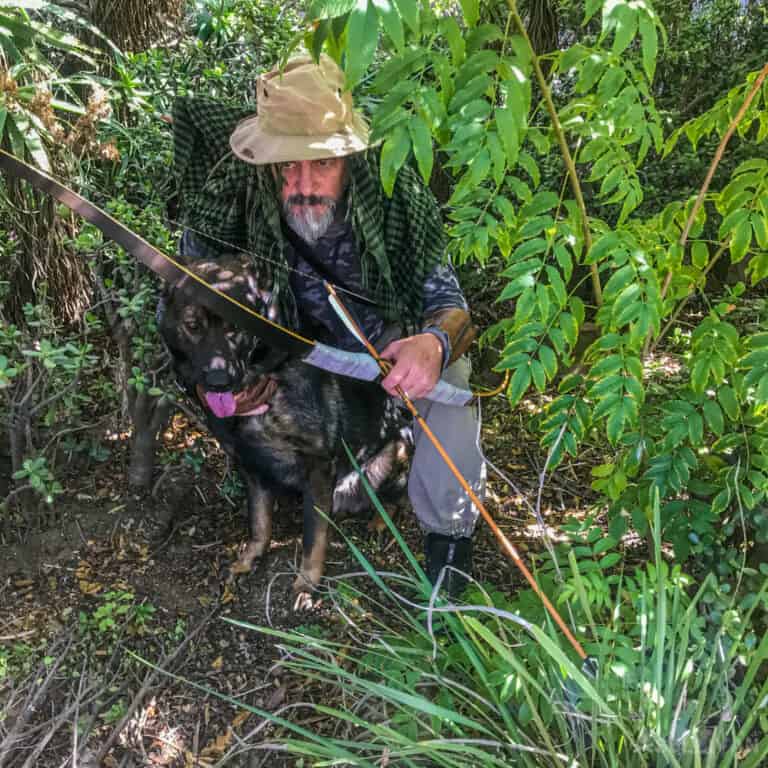
You would not be wrong; these tribes’ people have honed their environmental skills to the point of instinct.
For the most part, their weapons are basic, yet well suited for the purpose of hunting their quarry and maintaining themselves. The ability to provide for the tribe placed successful hunters at the top of the social ladder.
Hunting not only provide meat protein, but it also provided furs and skins for clothing, sinews for cordage, and string and bones for weapons.
No matter how basic the weapon, the more you practice the luckier you’ll get. The easiest weapon or tool at your disposal is the humble stone or stick.
From Mongolia to the plains of Africa, from the jungles of the Amazon to the mountains of the Americas and the cold lands of the North, the basics of survival remain constant and the rules of primitive hunting remain unchanged.
Humans have risen to the top of the evolutionary food chain by virtue of our ability to adapt, improve, improvise and invent new and more efficient ways of managing our environment.
From the time that we could mount a stone to the stick, humanity has embarked on a technological race to make our tools more efficient.
We progressed from fire-hardening sticks to developing balanced spears and arrows tipped with flint or other stone types to increase the lethality of our equipment, more efficient ways of hunting, and saving energy.
Primitive hunting skills and techniques are as valid today as they were in the mists of time.
The surviving tribes still utilize tried and tested hunting technology and methods, despite the worlds changing face. The reason is that they work, it is that simple.
Using modern materials for camouflage, and better footwear alone takes the hunter into the new world, improved manufacturing of the equipment we use, etc. has improved our chances of success but the primitive rules of hunting have not changed, and I cannot see how they will.
The practice of ancestral, ancient, and primitive skills is still actively taught to any that are willing to learn. And that is what we’re going to talk about today.
Table of Contents
The Three Survival Basics
Our survivability and pretty much every living thing depends on and revolves around the Basic Survival Three:
- Shelter
- Water
- Food
As a hunter you will have to be conscious of these three, the animal you are hunting certainly is.
Understanding where your food sleeps or takes shelter, where it drinks or finds water, and where it eats will all influence the type of fieldcraft you will have to employ in order to hunt effectively.
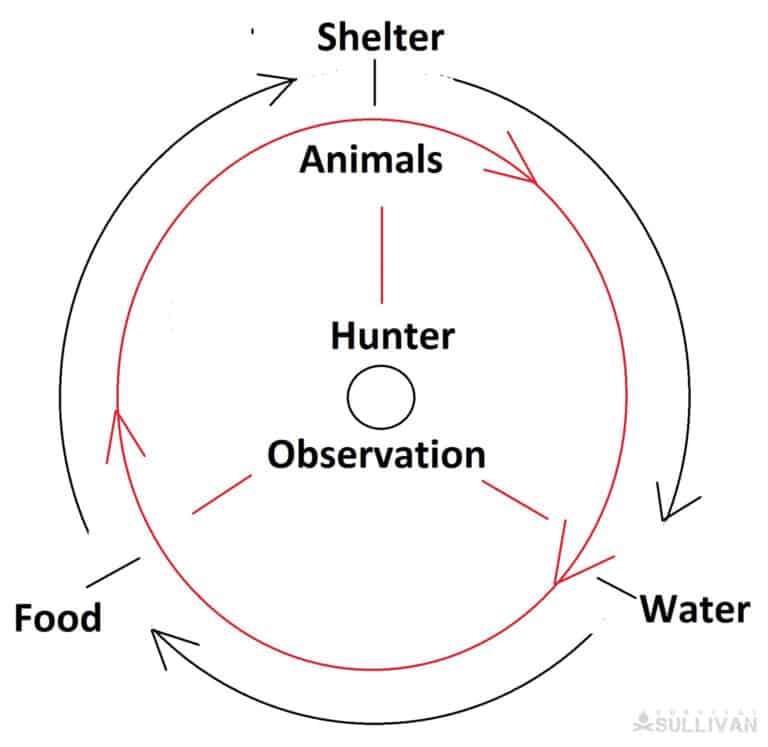
In a worst-case scenario, you will need shelter to maintain your body’s ability to hunt, and to create the tools you’ll need to be a successful hunter.
Water is the essence of life; you need it and so does your potential food source.
The game paths to and from the water source will give you an opportunity to observe your quarry, understand what animals are in the area and how they react to your presence.
Now that I have touched on the why of ancient knowledge let’s look at what is available to us in the field and how we best make use of the resources available to us, especially in a survival or SHTF scenario.
15 Things To Consider When Primitive Hunting
In a nutshell, here are the things to think about before you start hunting your chosen game:
- Observation of the Area
- Identify Quarry
- Where Does Your Quarry Shelter?
- Where Does It Drink?
- Where Does it Eat?
- When Does it Move?
- How Does it Move?
- Game Paths
- Identifying Tracks
- Choose a Method to Hunt
- Choose the Appropriate Weapon
- Move Like Everyone Else in the Environment
- Know Your Neighbors
- Immersion: Becoming Part of the Environment
- Becoming Stealth
Now let’s take them one by one in order.
Observation
By observing animals and birds as they go about their daily routine of moving from shelter to water and then to the feeding grounds, you will gain intimate knowledge of the environment and the ecosystem.
To be a successful hunter you will need this knowledge to find your quarry, move in its habitat and hunt it effectively.
If you know how your prey behaves in its environment when it follows the basic survival rules, you will know how to behave in its environment.
You will become part of the natural order of things and successful at hunting.
Observation is also about the terrain the hunter is moving in. Sheep and mountain goats like higher altitudes and rough open terrain.
Grasslands and woodlands harbor various game at different times of the day.
Knowing the area will provide you with the knowledge to navigate in the wild, pick the best areas for approaching your quarry, and to make the best use of the terrain for concealment.
Identify Your Quarry
What animals inhabit the area you are hunting in? This is the first priority, take time to familiarize yourself with the neighbors.
Some are easy quarry and plentiful, usually small game like rabbits, hares’ squirrels and birds.
Then there is a dangerous game like bison, pigs, wolves, mountain lions, bob cats, and lynx, try not to cross paths with these.
Know if they are in the area and give them their space unless you have no choice.
Large game such as deer, elk and moose normally abound in most wilderness areas, know which of them are in your area so that you can identify them by sight.
Observation will tell you about their various habits, and vital information for the hunter.
Shelter
Knowing where the various animals in your area take shelter will enable you to plan your hunt.
Planning makes the hunter effective, consuming less energy and providing the needed food supplies.
If the deer take shelter in a wooded area for the night and move in predictable patterns to and from their sheltered areas the hunter can plan his trip to coincide with the deer’s movement.
This goes for all species of animals and birds.
Water
All living things need water to survive, some will drink more often than others.
Animals and birds are sometimes found together and others will use the water source at different times of the day, this will enable the hunter to plan and utilize time to the best advantage.
Animals are vulnerable when moving to and from a water source providing the hunter with the opportunity to observe their movement, building on the hunter’s local knowledge.
Providing the hunter with the necessary insights into animal behavior, enabling you to be a successful hunter, to feed yourself the protein needed for long-term survival.
Food
Familiarity with the terrain and the animals that inhabit it will educate you on their eating habits, behaviors, mannerisms and routine. Animals will usually drink before heading to the feeding grounds and after a day of feeding.
Food, well that’s what hunting is all about, pitting yourself against an elusive prey in their back yard.
When Do Animals Move?
Animals are active at different times of the day and night; this is termed diurnal for daytime and nocturnal for nighttime.
With observation, a hunter will know when the best times to hunt certain animals.
Not all animals will hunt for food or drink water at the same time of day, some will move early morning and again in the late afternoon, while some will favor different times of the day.
How do The Animals Move?
There are herd animals or flocks of birds made of large numbers of the species, these animals will move differently to smaller groups and individuals.
Knowing how they move will allow the hunter to determine how alert they are to danger, how these animals react to danger, and where they will move to escape danger.
Herds or flocks are less skittish than smaller groups or individuals, as they have more eyes and ears to alert them to danger.
Understanding animal behavior makes them predictable and hunting them becomes less of a mystery.
Game Paths
Observation of the animals in the area as they move between shelter, water, and food will identify the paths they use as they make their way over the terrain.
Predictability is the bread and butter, so to speak of hunting success. It is possible to predict the animal’s movement along a given route.
The hunter will have an advantage in locating his quarry and hunting it.
Game paths provide insights into animals’ movement and the population density of an area, well used paths will indicate a healthy population, while less used paths may indicate less game available to sustain the hunter.
As a hunter, you may have to move to a different area to find a quarry.
Animal Tracks
Tracking is an essential primitive skill, with observation and practice, you will be able to match the animals you see to the tracks they leave.
Acquiring and developing this skill, will give the hunter valuable information about an area and tell which animals are present, without expending valuable time waiting to observe their movement.
Vital information can be obtained from the animal’s tracks, for example in which direction they are moving, if they are being chased or what they were doing, and how long ago they were there.
Choosing the Right Hunting Method
With observation comes knowledge and an intimacy with the environment, making for effective planning of a hunt.
For example, an abundance of deer and turkey in an area will require different methods of hunting to be effective in taking a quarry.
Knowledge acquired through observation will inform the hunter how these different animals live, find and use shelter, when they drink, and when, where, and what they feed on.
Turkey may require hours of patient waiting in one spot for it to come to you and be in the range of your weapons or trip a snare.
Deer may require a stealthy approach to be in the range of a bow and arrow, this is called the stalk, while they are at rest for the night or feeding on the open plain.
Choosing the Right Primitive Weapon
The hunter is in the field and decides on a quarry of opportunity or plans to hunt a particular quarry. You may have a bow and arrow with you, a spear, snares or slingshot, each weapon is effective for certain game species.
It would not serve the hunter to take on large game with weapons that cannot bring down or inflict enough damage to disable the quarry.
This is dangerous, a wounded animal can turn on the hunter inflicting damage and death, it can escape wasting time and resources for no gain.
Wounding your quarry with ineffective weapons is a waste of time, and will only spook the animals especially when you try to hunt them again.
Move Like Everyone Else in the Environment
Nature is neither quiet or silent, it is alive with the sounds of the living things that are moving in harmony with everything else.
Movement is usually the giveaway that spooks a quarry or that alerts the hunter to the presence of the quarry.
Moving like everything else in the neighborhood will give the hunter the advantage in taking a quarry.
I was a young boy traveling with my father in the Savuti in Botswana, a wild area and home to the Big 5.
We were fishing in one of the few times the Savuti River was flowing and three Elephants slid in next to me, no more than 20 meters away, on the river bank.
I only realized they were there when they began drinking.
If they had been lions or some other predator, I may have been dinner. The important lesson was to be aware of how quietly, even elephants can move.
Learn to move in the same way, to avoid being detected.
Know Your Neighbors
Everything has a language in the field, its up to you to allow the sounds of the wild to become familiar. Birds, frogs, deer, snakes, everything has a sound, they have habits and even a sense of humor.
Birds will sing or crow their good morning and good night tunes; this will tell you where the pheasant or partridge is roosting.
Learn the sign, read the sign posts.
Bears need a scratch post, it’s usually a tree along the game path, elk will rub an itchy shoulder on another tree, and some deer poop in the same place every day, it is called a midden.
These animal behaviors are sign posts to who lives and moves in your area.
These signs will tell you if you’re hunting in a good spot or if you should move because a bear is sniffing around.
Know when danger is around by the sounds of the other neighbors.
Immersion: Becoming Part of the Environment
Hunting even with the most expensive weapons and the best equipment your money can buy won’t make you a successful hunter, if you cannot immerse yourself in your environment, you will probably go hungry.
There is an old saying, “Even a blind squirrel finds a nut every now and then!”. Don’t be a blind squirrel, open your eyes and you will find your way in the wilderness.
Primitive hunting is not just about throwing a stone, spear, or stick at a prospective target, it’s about knowing and understanding what your target does and how to get close enough to maximize your strike rate.
Precision telescopic scopes mounted on a long-range rifle give the modern hunter a massive advantage over his quarry and has created lazy hunters. That’s the truth of it.
As a professional hunter, I have guided clients of varying ages and fieldcraft skills, the overriding advantage the most successful had was their ability to identify with the environment and adapt.
Success depends on you adapting to the environment in every way possible.
Stealth
Stealth is more than moving quietly, it is moving without disturbing the natural balance of the area.
Unknown sounds, smells, and objects inspire animals to flee, avoid and consider dangerous anything that is out of place.
Stealth is about situational awareness, being aware of what is going on around you, and being purposeful in everything you do.
North American Game
I am listing general hunting species that could be found depending on where you are hunting, the list is a general description of the species.
There are a number of subspecies under each heading that will be endemic to different regions and environments.
Large Game
Large game is not to be taken lightly, these are large animals that are either predators or very big prey animals that are not afraid to defend themselves. Some can be territorial and all will defend their young.
Although this article deals mostly with primitive weapons, you can make yourself, the bow and arrow require special mention.
If you are armed with a bow, it needs to be of adequate poundage to launch a heavy arrow with a broadhead to do the maximum damage.
A heavy bow can hunt large and small game effectively. A bow of 50 to 60 pounds pull is the recommended minimum, especially for large and dangerous game.
Hunting with primitive weapons takes skill, and hunting large game takes skill, nerve, and knowledge of the animal and its environment.
Although the payoff in taking down an Elk or Moose is meat for weeks or months if dried and processed, the risk of a direct attack is offset by the high degree of personal risk to the hunter.
Here, pit traps are invaluable in hunting method, trapping the animal in a hole where the hunter can then finish the quarry off without too much risk.
Do not take on predators unless you absolutely have to defend life and limb.
In this case, discretion is the better part of valor. Even if you are starving, rather back off from your quarry and live to fight another day.
If you do need to either defend yourself or the opportunity presents itself to take game, then the spear and bola are your first choice of weapons.
The bola can bring an Elk or Moose down by tangling up the legs allowing the hunter to use the spear to best effect.
The spear can be used first and then the bola to bring the wounded animal down. This goes for deer, pronghorn, goats, and sheep.
A well-placed stone to the head can knock down large game, the likelihood though is slim, so I don’t recommend the throwing stick, the sling or the slingshot for any of these species.
Their thick skins and heavy bone structure will more than likely absorb the strike and alert them to your presence.
- Bear (Black Bear, Brown Bear, Grizzly Bear, Polar Bear)
- Bison
- Caribou
- Mountain Lion
- Deer (Black-tailed Deer, Mule Deer, White-tailed Deer)
- Elk
- Goats
- Moose
- Pronghorn
Small Game
This title is somewhat deceptive as some of the animals are predators and tough. Pigs in general, I would term as large game, not to be underestimated and hunted in the same way as large game.
Preferably, hogs should only be hunted as a last resort or if you must then with a heavy spear or pitfall trap and spear.
This goes for badgers, wolves, bobcats, lynx, and wolverines. They are tough and have no fear of attacking humans, especially when cornered or wounded.
Besides they are not good to eat, best left alone in favor of a better source of protein.
Armadillos I believe are good to eat and taste like porcupines, that said they are hard to hunt, they can move at speeds up to 30 miles per hour and their hard outer body plates are not easily pierced by a spear or arrow.
In rare cases, they can also be the carrier of leprosy. I would err on the side of caution.
Everything else on this list of small game can be hunted with the list of improvised primitive weapons. Porcupine is best taken with a spear and can be hunted where they take shelter in a burrow.
Some of the small game you could be hunting (whether for food or to save your life) include:
- Armadillo
- Badger
- Beaver
- Bobcat
- Coyote
- Ferret
- Marmot, including woodchuck
- Marten
- Muskrat
- Otters
- Pig (feral swine, javelina, wild boar, wild hogs, wild pigs)
- Porcupine
- Prairie Dogs
- Rabbit & Hare
- Raccoon
- Rat, including Kangaroo Rat and Wood Rat
- Skunk
- Squirrel
- Weasel
- Wolf
- Wolverine
Upland Birds
With birds the sling, slingshot, throwing stick, and bola come into their own.
The capacity to launch a stone projectile at the relatively soft-skinned bird can bring it down easily and feed you with regularity.
A direct hit with a throwing stick will kill or break a bone to disable even birds as large as a turkey.
- Crow
- Dove & Pigeon
- Francolin
- Grouse
- Partridge
- Pheasant
- Quail
- English or House Sparrow
- Starling
- Turkey
Waterfowl
Waterfowl are just as susceptible to primitive weapons as the upland birds listed here.
The exceptions are geese and swans, these water birds are tough and with heavy feathers to protect their bodies.
A direct hit to the head or neck will disable or kill and require more refined skill to be accurate.
- Duck
- Goose
- Rail
- Snipe
- Tundra Swan
- Woodcock
Fish and Turtles
The spear and the rubber hand spear are the most effective of the primitive weapons.
Spears are usually two or three-pronged with a barb or swing arm that will prevent the fish from slipping off the spear.
Turtles are deceptively fast and ferocious, delivering a crippling bite to the unwary.
They can be disabled with a direct hit to the head from a sling, slingshot, or the spear; however, the thick shell can cause the projectile to glance off.
Prepping for a Primitive Hunt: What To Pack With You
There are two main types of hunting expeditions you may be a part of:
- The Planned Hunt
- The Unexpected Need to Hunt
Both of these situations are, in fact, planned, the difference being that an unplanned primitive hunt is usually due to unforeseen circumstances that require you to survive a situation.
Besides your brain, the next most important single piece of equipment is a knife.
Working on the assumption that you have some accumulated knowledge and are familiar with your surroundings, planning a trip into the wilderness will require equipment. If you know what your primary quarry is you can plan accordingly.
Before heading off into the field, I prepare my equipment for the day or days ahead.
Whether you are fishing or hunting, both of which fall under the primitive hunting banner, your equipment needs to be in the best possible condition.
Equipment condition is relevant irrespective of age or type. Growing up my skill as a hunter was honed in the field of trial and error.
Using primitive weapons only, it is important to make sure they are serviceable; you will only get one shot at a quarry.
If you miss you will have to start your approach again, this time with a quarry that is alert to your presence.
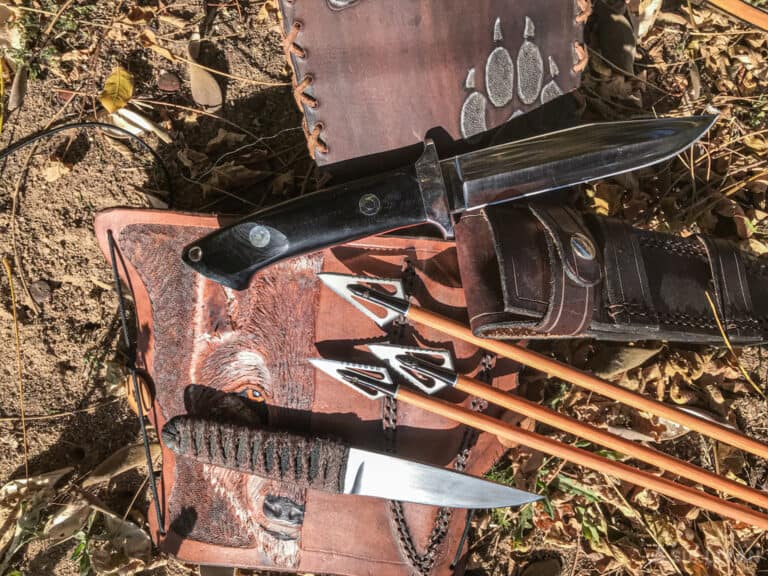
Check all fixings, knots, and tie-downs. I would start with the weapons I am using. Make sure that spearheads, arrowheads, and blades are sharp, clean, and oiled.
Hunting with my traditional bow, I have an effective accurate range of 25 to 35 yards. My arrows are tipped with modern broad heads to maximize the impact and efficiency of my arrow.
The same holds for rifles, check the sights and make sure you have the correct ammunition for the rifle.
You may laugh but it’s a true story, I’ve had hunters arrive with no ammo or the wrong caliber for their rifle.
Dress in dull, earth colors or camouflage clothing if you have it, it breaks your shape. Footwear must be serviceable and ensure that they will not let you down in the field. Your feet carry you everywhere, look after them.
Pack a kit that will cover emergencies. This will be weather, medical and mechanical, as in fixing hunting equipment should it get damaged.
Sustenance on the hunt will be important to maintain your energy levels and your efficiency in the field.
If your tired, fatigue will cause you to miss, squandering a hunting opportunity. In a survival context, this could be catastrophic.
Prepare some easy meals that can be eaten on the move and that don’t require preparation.
You may be in an ambush site or hide where movement will need to be at a minimum and noise restricted to avoid detection.
Once your primary target is identified you can draw on your observation skills to plan where the hunt will take place and plot your killing ground.
Check out the area days before and place any branches and cover materials over your hide-out so that any animals passing through the area will have inspected the area or accepted the changes as normal.
Funneling animals through a narrow space or defile on a game path using branches and undergrowth is a really good method of ensuring your quarry moves through a certain area and into the range of your weapon.
Using this method, it is very important to lay out the funnel days in advance so that animals get used to the changes.
If you are laying out snares then a trapline in a productive area should be laid out and visited everyday to ensure your catch is not stolen by scavengers and not to prolong any snared animals suffering if it is not killed outright by the trap or snare.
Generally, planning for a hunt is the same, no matter the tools involved, it’s the skill level required to be successful that sets the primitive hunter apart from the modern-day counterpart.
Primitive Hunting Weapons
At the most basic level, our need to survive will depend on our ability to improvise a means to extend our reach, create distance between ourselves and a threat or close the distance between ourselves and a target.
The most accessible weapon or tool at our disposal is the humble stone and stick. Unless you are in a desolate sand desert, which is also possible these are your “go-to’s” in an emergency.
The Stone
“Not all stones are equal”. Obvious, right? Well not always, remember you want to extend your reach or close the distance. Let me explain…
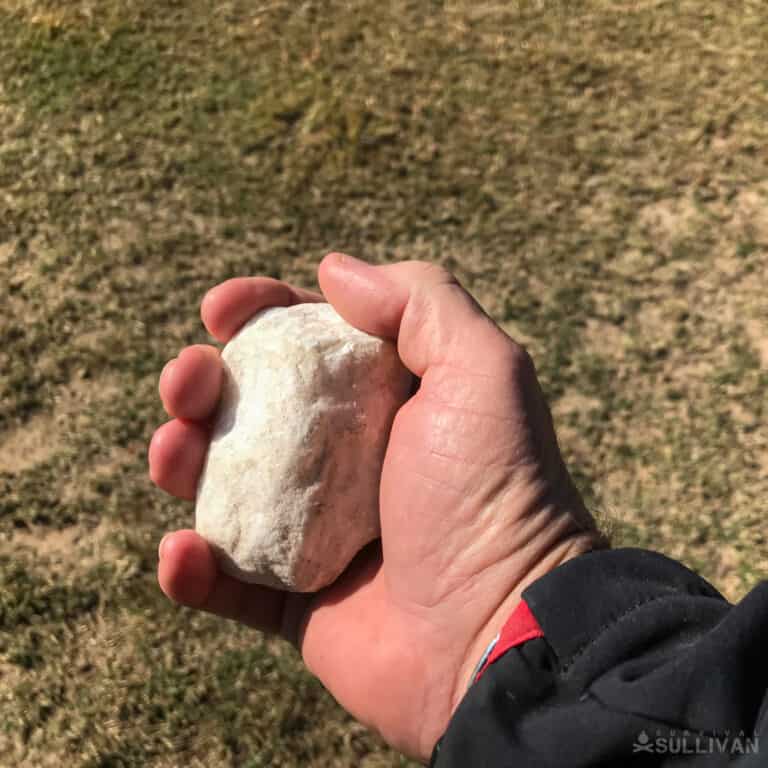
A light round stone will be aerodynamic and will travel far when propelled, either by throwing it or loading it into a throwing arm, round flat stones are also aerodynamic, and can travel further than a round stone.
Skimming stones across a pond is a fine example of how this works, the flat surfaces allow for better use of the kinetic energy imparted to the stone by throwing or spinning it.
The problem is that your body can only impart a finite amount of energy.
If the stone you pick up and throw is too light it lacks the weight to cause enough damage to either bring down the quarry or disable it long enough for you to dispatch it and provide you with a meal.
If too heavy you cannot throw it far enough to reach the target. It is a balance between the weight and the amount of energy that you impart to the stone for it to be effective.
If the stone is the projectile, how do you extend its range?
You do this by increasing its velocity or the speed at which it leaves your hand. You could throw harder or improvise a piece of equipment to assist you to do this.
The Sling
Think David and Goliath, here the sling made a name for itself that has echoed across time.
A device so simple that it was ignored by the mighty in favor of the sword, yet the sling has made its mark as a major component of some of the greatest military units and armies across time.
The Romans and Greeks had entire regiments dedicated to the sling and stone, that’s how potent a weapon it is.
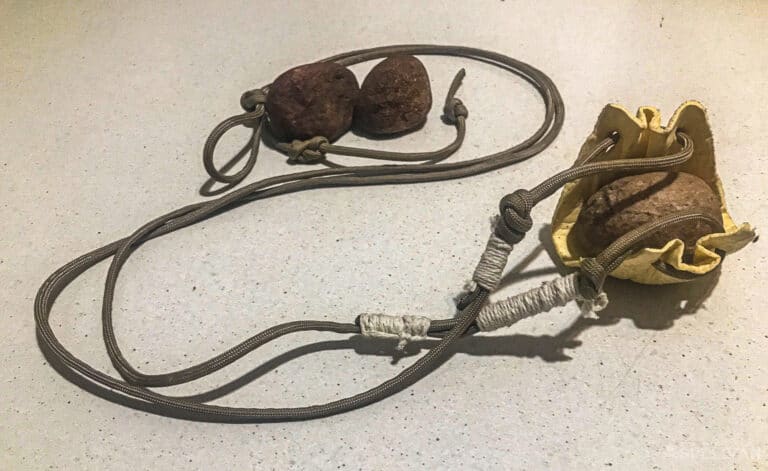
As a kid growing up on a farm, my earliest attempts at hunting were supported by a sling. It’s pretty much two lengths of string and a tab in the middle joining the two pieces.
By placing the stone in the tab and swinging it overhead or overarm, even underarm, and then releasing one string end while retaining the other, the stone is given the velocity of the swinging motion.
Ranges of 70 to 100 yards can be accurately reached with a golf ball-sized rock, the rounder the better.
That’s is considerably further than most people can throw accurately and still have enough kinetic energy left to put the target down.
A modified version of the sling is to attach it to a long stick to create a staff sling.
This will increase your range of motion allowing for stones the size of an apple to be hurled with accuracy the same 80 to 100 yards.
The main benefit is that you can bring down a large game with a direct hit to the head.
Slings are suitable for small to medium game like squirrels and rabbits. Also, birds of any size partridges, pheasants, ducks, geese and turkeys. Your stealth and local knowledge will be invaluable in securing your quarry.
A word of warning when it comes to boars, wild hogs, and feral hogs, these animals are tough, and unafraid, with heavy-set skulls and bad attitude.
Tackling these pigs is not recommended, the payoff is huge but the likelihood of being attacked and injured, badly, is high and not worth the risk.
All of these weapons require regular practice in an open, clear space without human or animal traffic. Start slow, get the action right that suits you and the timing of the release.
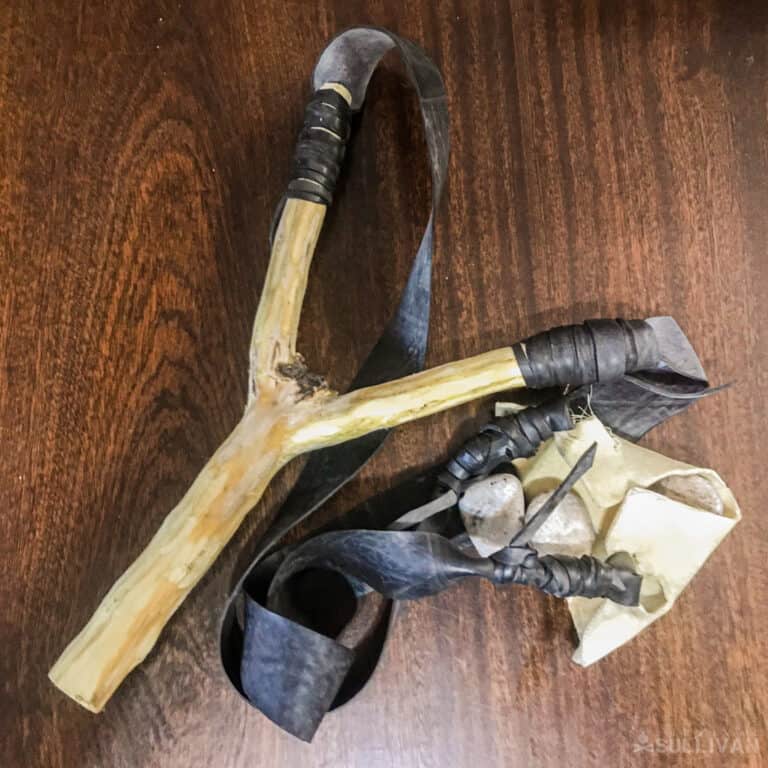
The Catapult or Sling Shot
Every kid in my neighborhood was armed with a Catapult or Kattie as we called them. Armed thus we harvested field animals on a regular basis growing up learning the necessary fieldcraft lessons.
Tracking your quarry is one thing, knowing how your quarry behaves makes tracking and behavioral anticipation a cornerstone of primitive hunting success.
Being farm kids though we had things like old used inner tubes from tractors and farm vehicles.
These make great rubber arms for the slingshot, and you can carry them with you wrapped around the sheath of my field knife:
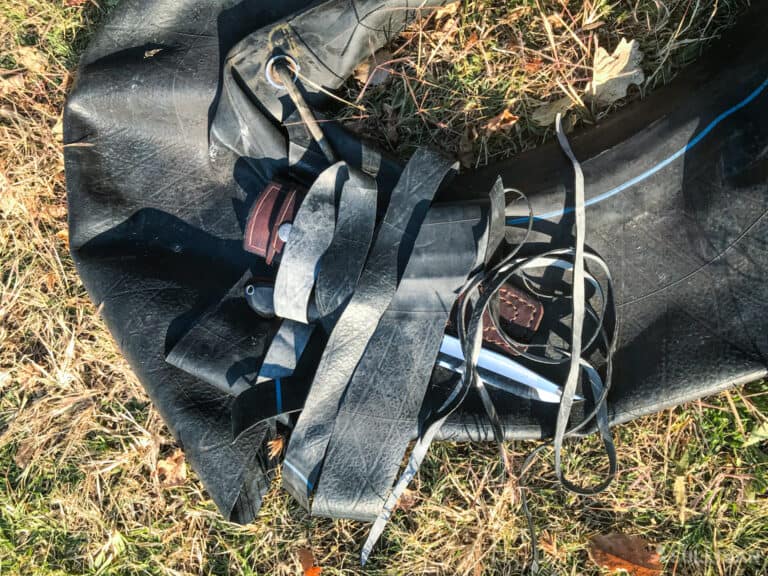
A slingshot is a fantastic hunting weapon, it’s accurate (with practice), and has awesome range.
It keeps your movement to a minimum when being used, allowing for more stealth and less likelihood of spooking your intended quarry.
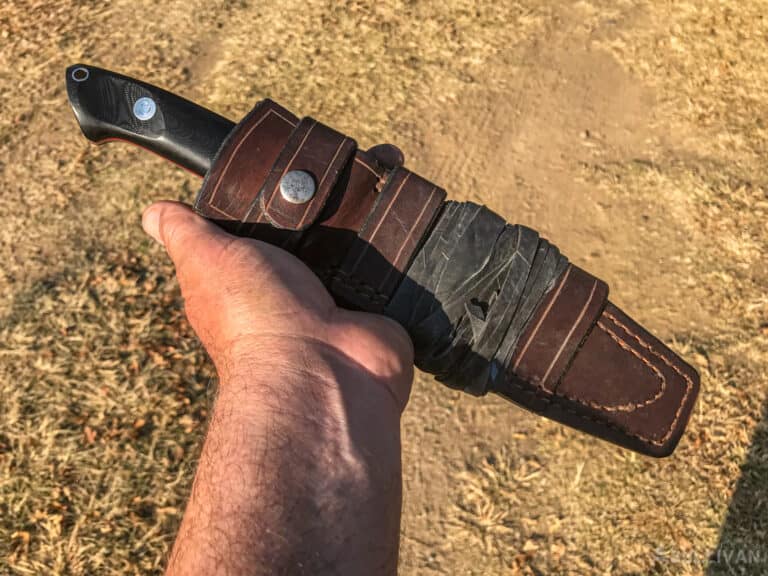
Depending on how powerful your rubber bands are small, medium, and large game can be taken especially with a direct hit to the head.
The Bola
This is a very easy piece of equipment to use, it is versatile and can bring down small to large game. Its origins are ancient with bolas being recorded in the Inca empire.
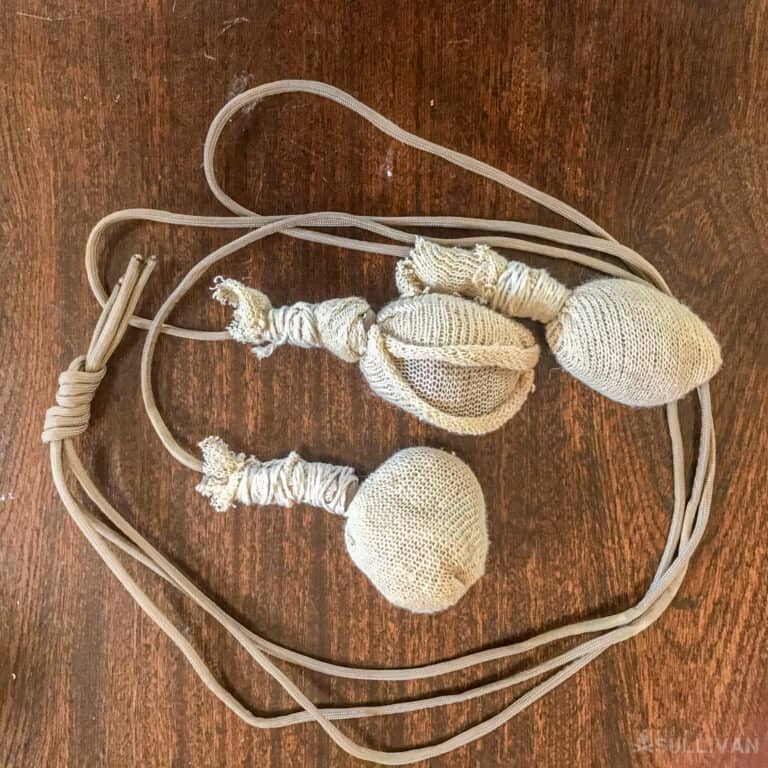
A sling releases the stone while the hand retains the sling so that it can be reloaded.
The Bola, on the other hand, is released with the stone weights and is used to ensnare the quarry’s legs to bring it down.
Bolas are usually made of two to three cordage arms, measured out similarly to the sling. I like using a three-cordage Bola as it gives me more balance on the release.
The great thing about combining multiple tools (like bolas and spears0 is that you will be able to immobilize your quarry, and then dispatch it while reducing the risk of injury to yourself.
In a survival situation, you need to manage exposure to risk as much as possible.
The Humble Stick
The Egyptians were adept at using throwing sticks to hunt small game and birds. It is the simplest of primitive weapons, in the same league as the stone and just as accessible.
An Egyptian throwing stick is similar in design to the Aboriginal Boomerang, which developed independently and dived by thousands of miles.
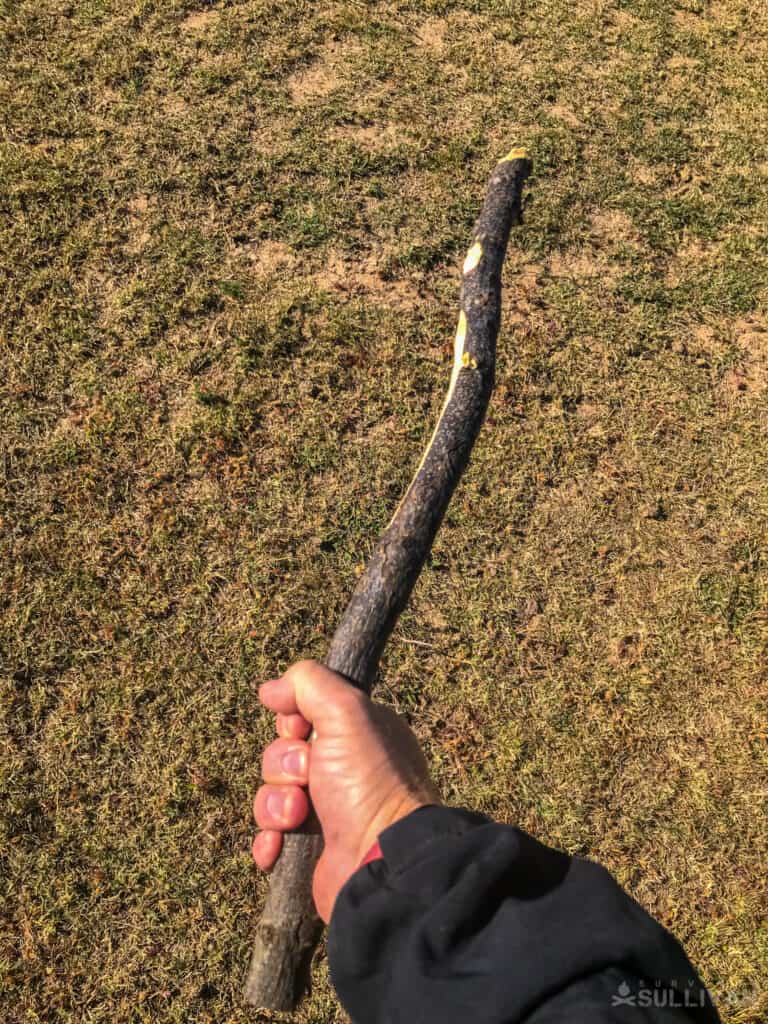
There is no doubt that throwing sticks have been in use since before recorded time, when a stick was picked up and thrown, scoring a direct hit.
This would have prompted the thrower to “do it again,” and develop not only the skill to be accurate every time but also to refine the stick into a more efficient hunting tool.
Sticks in the shape of a club, a thin stick with a bulb on the end is an effective throwing weapon, the weighted end working much like the stone from a sling and the thin end proving the pivot, as the sling would to provide the energy to propel the stick through the air.
The Staff and The Spear
The longer stick or staff is the next easiest survival tool to lay your hands on and has been around as long. Staves have been employed as working tools, crutches, and weapons from the beginning till now.
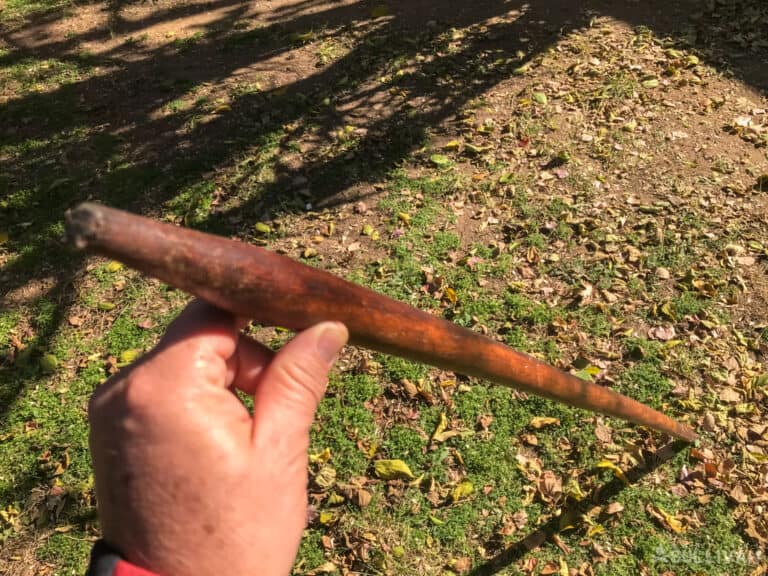
I trained in the use of the long and short staff during my martial arts development and even in the use of the shorter kali sticks or escrima sticks used for Filipino stick fighting.
These paired sticks and staves were developed to counter-edged weapons and extend the user’s reach to avoid being run through by a sword or spear.
They are highly effective close-range weapons and in the right hands can dispatch pretty much and small to medium game.
A natural evolution of the staff is the spear when we decided to increase the lethality of the staff by adding a point and stabbing with it.
One end of the staff can be sharpened and in the case of wood-heated and burnt in the fire to harden the tip to create a lethal stabbing and throwing weapon.
As our skill with stone and metals increased the penetration of the spear and so to its lethality.
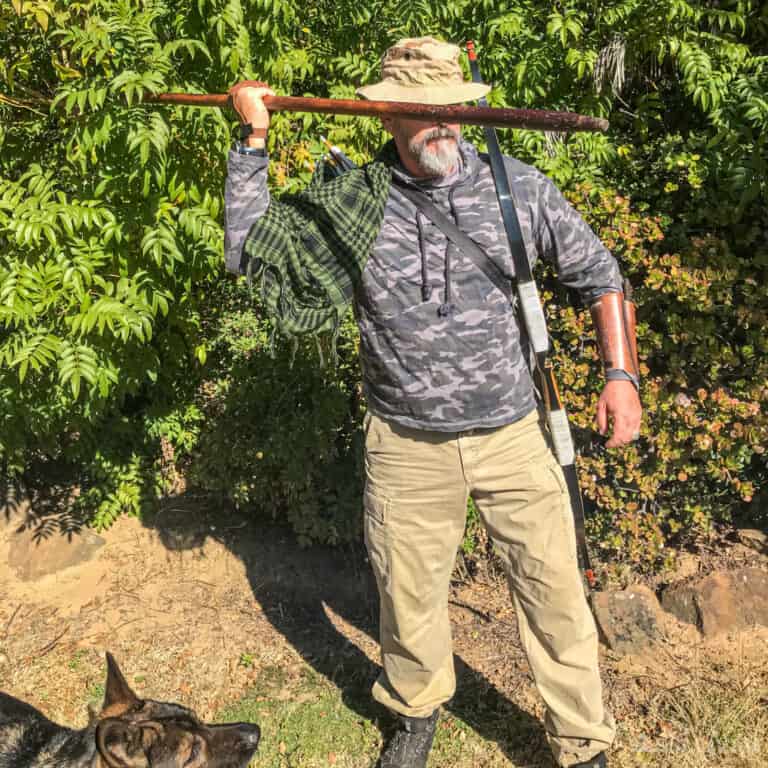
It can be noted here that early humans hunted massive animals with stone-tipped spears, archaeological discoveries of early human settlements and their trash dumps, reveals that stone-tipped arrows and spears allowed these early people to hunt efficiently and effectively.
In a survival situation, you can use a spear to hunt fish, hunt small to large game, and even hogs if necessary.
Again, a word of warning, the bigger the quarry the more likely it will be able to bite, scratch or use its horns to do you harm.
The Rubber Band Pole Spear
A derivative of the catapult is the rubber band propelled hand spear. This is an outstanding fishing spear, working well submerged in water.
It can be used to harvest all manner of water creatures including beaver, frogs, and even some waterfowl.
The rubber band hand-powered spear can also be used to hunt land-based animals, especially those that find shelter in burrows or birds roosting at night on branches.
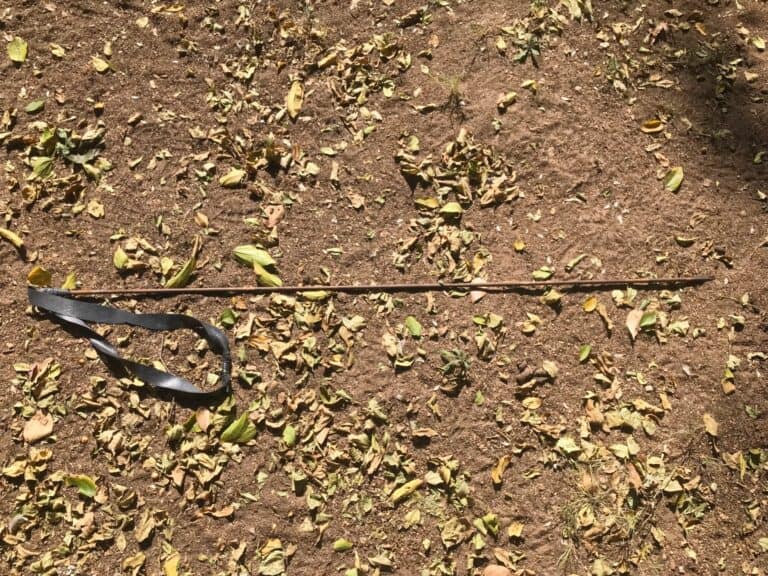
This spear is not thrown and is less likely to be lost when used as it is still attached to the hand by the rubber band.
The Bow and Arrow
A bow was the ultimate projectile launching weapon till the invention of the firearm. Even then the bow has been the province of everyman.
It is accessible and can be made by anyone with the barest of essentials and some guidance.
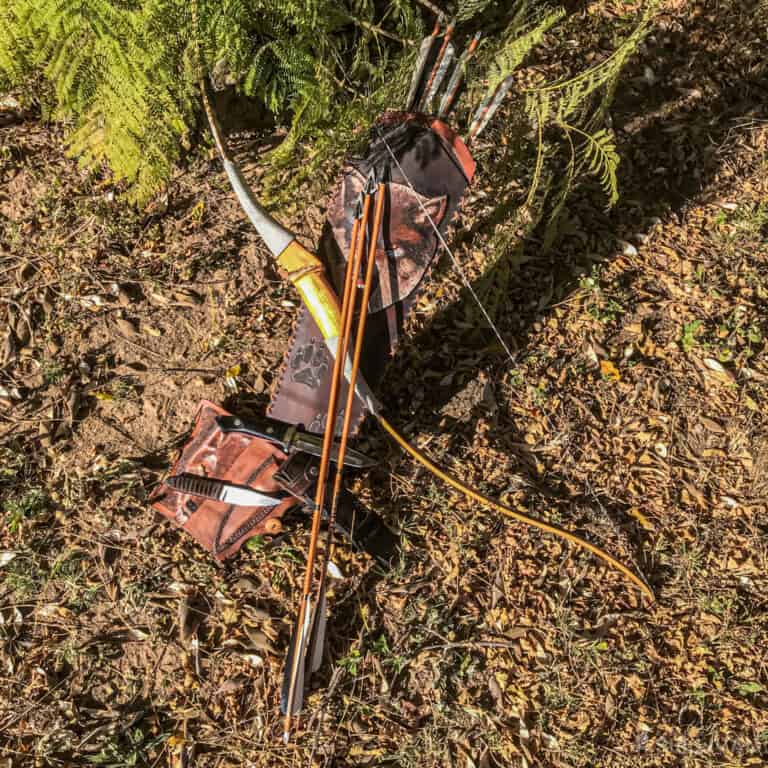
I have placed the bow at the end of this list of primitive weapons because it is the pinnacle of primitive weapons.
The evolution of the modern bow and its capability is evidence that the bow is far from obsolete. If anything it is re-surging as hunters seek the challenge of pitting themselves against their quarry.
Hunting Techniques
Stalk
The stalk is concealment, camouflage, and deception, the ability to move through the environment unseen is the basis of immersion into the environment.
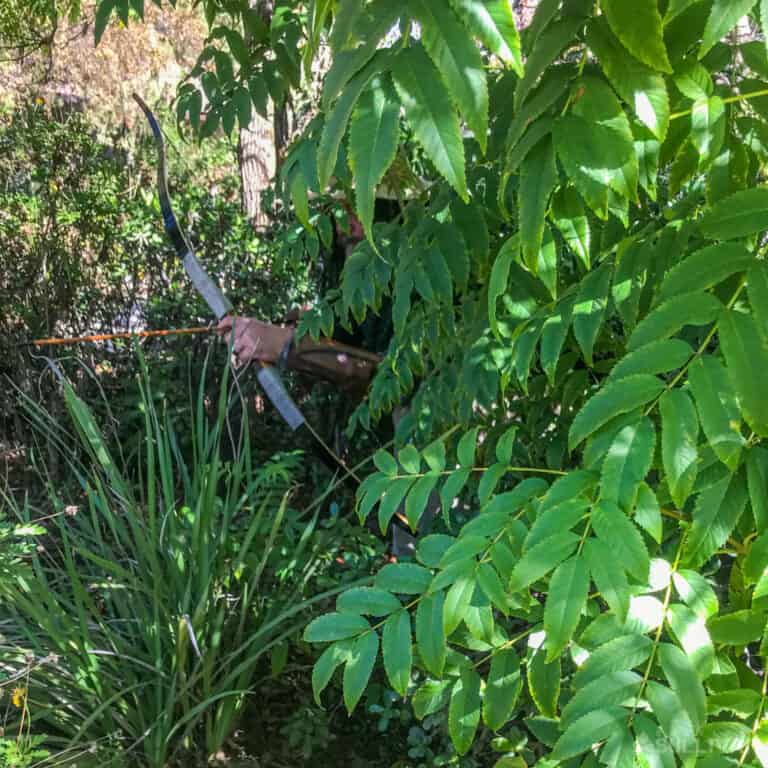
Move like everything else, the use of decoys, animal skins, and the gillie suit is credited to English game keepers and made popular by snipers, is used extensively by hunters to disguise their shape and presence.
These techniques have been used by hunters since the dawn of time, in one form or another.
Animals that are feeding do not move quickly, they gently browse and graze, all movement kept to a minimum.
Anything that moves fast or carelessly garners attention immediately. You are not the first to hunt these animals.
Your quarry’s flight response is highly developed, instinctive, and will kick in the minute they suspect that they are being targeted.
The primitive hunter is well aware of this and makes the approach slowly, with a minimum of noise and obvious movement.
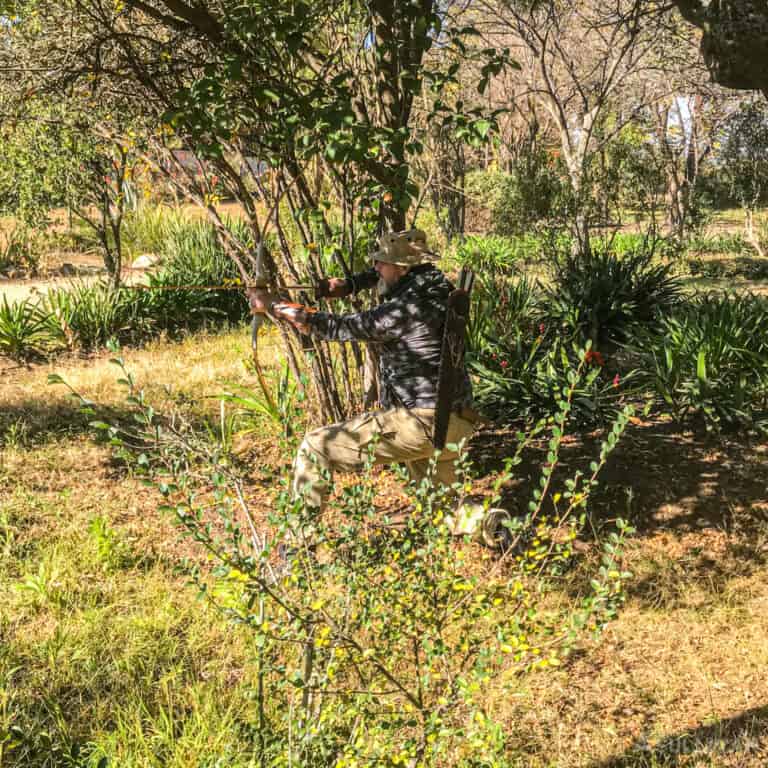
You need to look like everything else like you belong. Standing out makes you well obvious and creatures react badly to anything that doesn’t belong.
Most animals will shy away from anything that is out of place in their environment.
You will have to adapt to the environment by dressing like the environment. Camouflage has become an everyday fashion item, yet in the bush it is the difference between success and hunger.
In a survival situation use the vegetation as a guide and the animals to help you make decisions on the way to disguise yourself.
If necessary dirty your clothes or natural staining by rubbing them and rinsing them out.
Your smell is distinctive and any perfume will be totally out of place. The best is to try to remain neutral, the human body odor is quite distinctive so bathe in fresh water as often as possible.
Moving through the environment will require awareness, crashing through the underbrush will alert anything in earshot that your clumsy self in on its way, watch where you put your feet, and avoid standing on branches that will break or leaves that will rustle underfoot.
If you have to move through a cluttered area while hunting, shift the debris before standing on it.
The Native Americans’ use of leather moccasins to silence their footfalls while moving through the bush is a prime example of situational awareness, adaptation to the environment, and apex of behavioral immersion… becoming one with the ecosystem.
Running is a sign of pursuit for prey animals, so sharp and quick movements will alert your quarry not only to your presence but that you are a threat.
They will disappear into the bush and evaporate like steam in the wind but not before raising the alarm.
The alarm call of disturbed birds will often warn all the inhabitants within earshot, in Africa we have the Grey Lourie, a bird also called Hunters Bain, as its shrill alarm call will alert others to your presence and the bird will often follow the hunter as he moves, raising the alarm all the way.
Familiarity with the sounds of the bush and the creatures that inhabit it, allows the hunter to know when to change tactics, to know that the quarry is vigilant or relaxed or ready to sprint away.
The sounds of nature tell a story, the sounds will alert you, the hunter, to a quarry’s presence or to imminent danger.
An old hunter’s piece of advice holds here, ”Move downwind of your quarry.” Keep this in mind, determine the wind direction, see how the plants are bending or toss some dust in the air and see which way it blows.
Keep the wind in your face, it will disperse your scent away from the quarry, assuming the quarry is on your 12 (in front of you).
The wind will also disguise the sound of your movement, sound travels, so let it travel on the wind behind you.
Stay in the shadows on a tree line or rock out crop, this will aid you in the approach and disguise your shape.
If no cover is available, you will probably have to make your approach by lowering your profile, either bending low at the waist or hands and knees through the grass or underbrush to remain unobserved.
The more you practice this the sharper and in tune your awareness will become; the eyes adjust to see what you would not have noticed before.
Your ears will pick up on sounds that are out of place, and your sense of smell will adjust to the environment.
Just as your prey is attuned to changes in the normal to warn them of danger, so you will become attuned to your environment to take advantage of opportunities to hunt as they present themselves.
Spearing fish and frogs work the same way, where stealth is even more important, as water is their natural home, not ours. Fish will remain still giving you the opportunity to approach if handled carefully and with stealth.
Ambush
Here I want to introduce a hunting technique that will assist you, hunting from a hide, laying wait in a camouflaged position usually concealed on a game path.
Your quarry will be moving to the feeding grounds or the water hole. Patience is required, so prepare to take your time.
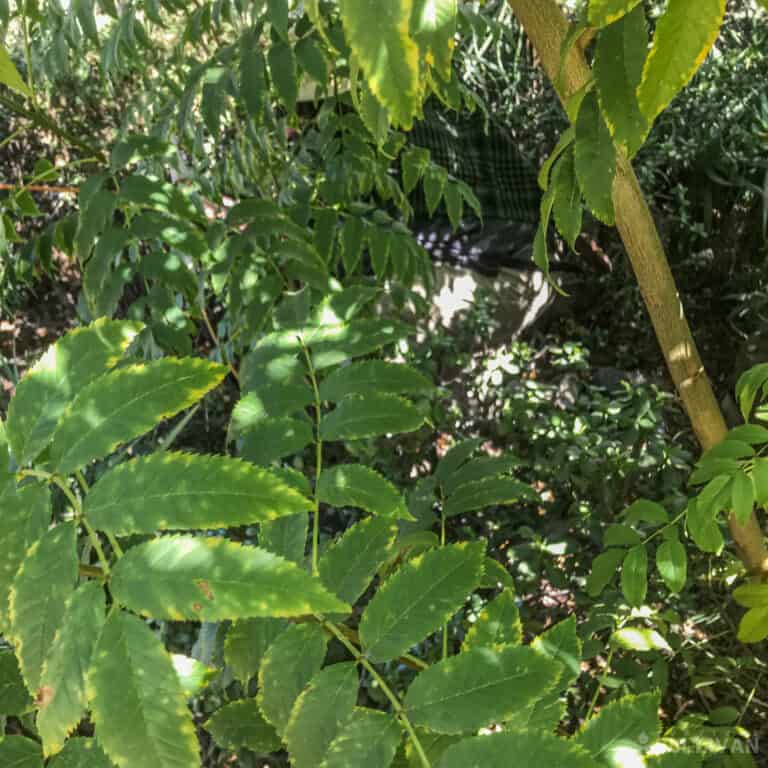
Knowing when the animals move to water or away from water heading to the feeding areas will get the hunter into the ambush position early so as not to miss the hunting opportunity and conserve valuable time by not waiting on an unproductive game path.
Because the weapons you are using are designed for close-range applications, as a hunter you need to be in range.
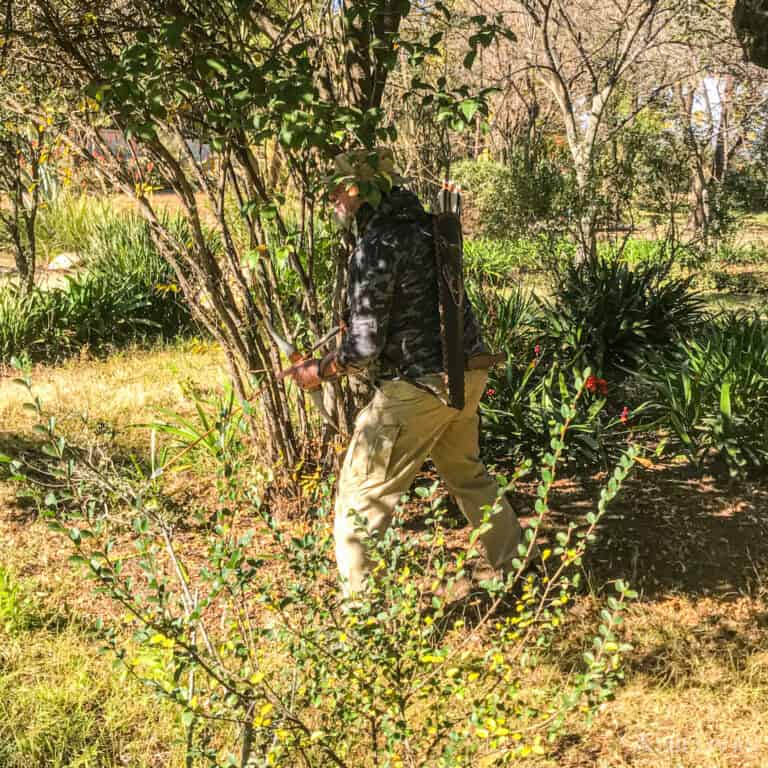
The funneling technique will keep your quarry boxed in and on the path. giving you a chance to launch a spear or arrow. This is the basis of hunting from a hide or tree stand.
Ambush Using a Pitfall Trap
If you have the time, you could dig a pitfall trap on the same path, this is especially useful for hunting hogs and boars.
The game can be driven along the path; the game is often less cautious when in flight. Pitfall traps used in conjunction with the funneling technique are very successful but time-consuming and cannot be left unattended.
Once your quarry has fallen into the pitfall you can approach in relative safety and finish off your quarry with a spear.
The game will become weary of an overused hunting area and technique, just like humans they adapt to changing circumstances, especially threats.
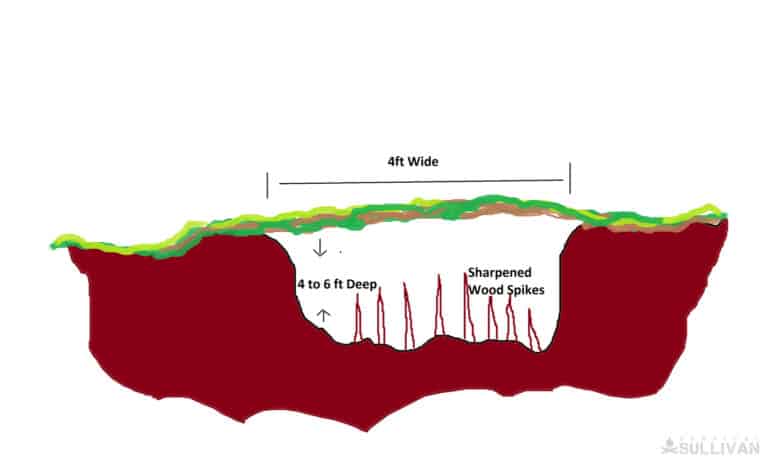
Pitfall traps are dangerous and must be well marked on a path to avoid endangering yourself and other game that you are not intending to hunt.
It is not a clean kill method; the hunter will have to move quickly to dispatch the game avoiding prolonging any suffering.
In a survival situation, the hunter must minimize their chances of injury while ensuring the harvest of valuable food sources.
Ambush Using Bait
Baiting your ambush site is a way of enticing your quarry into the “kill zone”, this will be the space that you have measured out and “ranged” for your weapon to be the most effective.
That local knowledge you gained observing the animals in the area, will now come in handy.
By knowing what your quarry likes to eat, you can use this information to bait your ambush area, this will draw in your quarry giving you time to lose off with one of your weapons.
The same goes for water use, animals and birds for the most part will drink twice a day. In the early hours of sunrise and in the late afternoon before sunset.
This will give you the opportunity to ambush your quarry on their way to, from or at the watering hole.
Tracking
The visual recognition of clues in the wilderness is a vital skill, not only will know what animals are in the area, you will now what can be eaten and what wants to eat you.
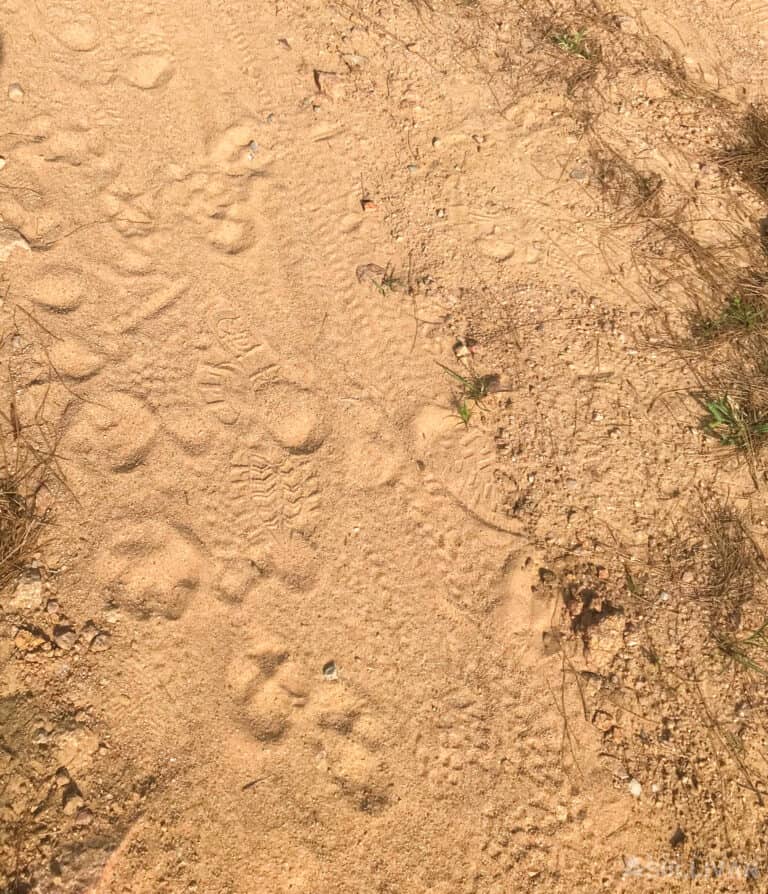
Using observation to identify the animals in your area and following up with further study once they have past your observation position you will become familiar with which animal makes what track.
Tracking will save the primitive hunter time by identifying quarry without having to take up an observation post.
Knowing how fresh the track is, allows the hunter to track his quarry using stealth to get within range.
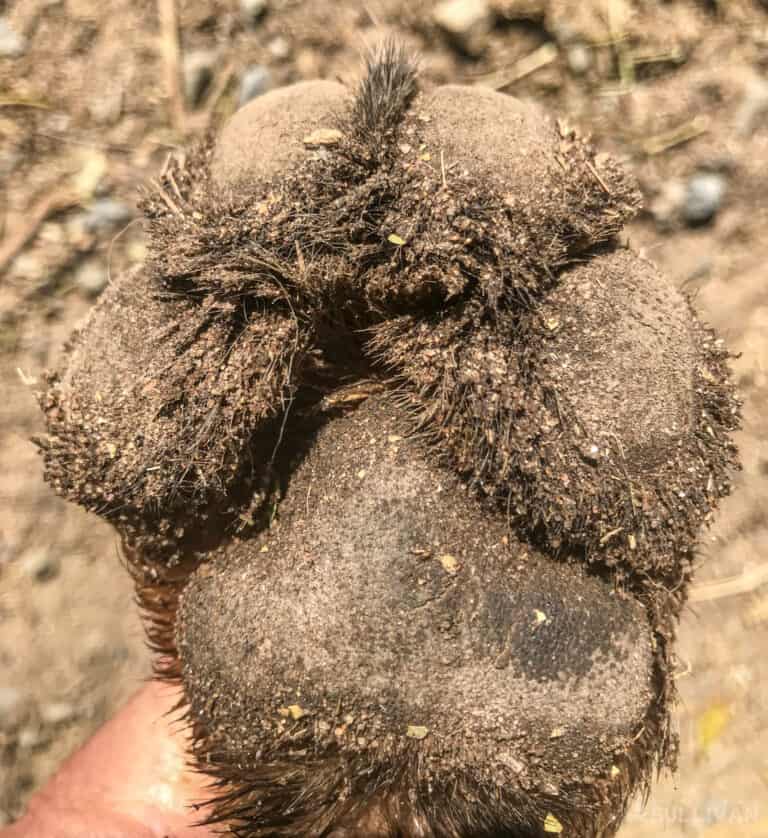
Turkeys, partridges, pheasants, and quail are ground birds that generally only fly when pressed. Waterfowl will take to the water before taking flight, these are the opportunities to strike.
Checking the tracks, they leave will allow the hunter to understand the habits of the quarry, the range of the animal or bird’s water and food.
Be Mindful of Hunting Laws and Regulations
In The USA
In the US, primitive hunting is defined as hunting with a black power rifle or smoke pole as its colloquially referred to.
For the purposes of this article, I will focus on the real primitive tools of the trade, bows, and arrows which have to meet a minimum draw weight depending on the state you are in, and a spear.
It is important for you to bring yourself up to speed on the legal requirements for your state before you tackle a planned primitive hunt.
Private land is excluded and exempt from most of the US regulatory restrictions, but again the onus is on you to be familiar with state and local laws and statutes.
Spears specifically is restricted to four states: Nebraska, Oklahoma, Alabama, and Hawaii.
Bearing all the legalities of hunting on state land in mind, if you chose to hunt primitive, you will need to be familiar with your weapon of choice. That is the essence of planning and success, familiarity with all aspects of primitive hunting.
Canada
In Canada primitive hunting big game with any but a bow or smoke pole is illegal and will get you into trouble with the law. Please be sure to familiarize yourself with what constitutes legal hunting in Canada.
Hunting small game with primitive weapons is unclear, so I suggest you err on the side of caution with regard to spears unless you are in a survival situation.
Read through the feral and provincial laws that apply to all Canadian game species open for hunting.
Europe
Hunting with spears and other primitive weapons was considered a sport in the earlier centuries, since then the European perspective has changed considerably.
Only bows and crossbows are allowed to be used for hunting and then only under certain conditions. Modern rifles and black powder rifles are legal and governed by law.
Be sure to read the law pertaining to hunting in Europe if you are planning to hunt there.
Australia
Australian Law on the use of spears for hunting is not clear at all. Their illegal weapons list is long and detailed and spears are not addressed under the local game management laws.
That said, hunting hogs with spears is popular in the outback rural areas and certainly is sanctioned for the indigenous aboriginal people of Australia.
Hunting sticks and boomerangs fall into the indigenous category of hunting and are practiced as a way of life for the Aboriginal peoples.
Bow hunting is allowed with defined parameters and governed by the national body. Federal and Local Legislation for various provinces differ and licenses for certain species are required, be sure to make yourself familiar with these legal requirements.
South Africa
Hunting on the African continent is an experience like no other, considering the diversity of game available for hunting and the plethora of hunting opportunities across the continent.
The African Safari is the pinnacle of hunting, with the BIG 5 the jewels in most hunters’ crown.
I have hunted extensively with the bow in Africa and guided many hunts for edible game, including the mighty African Buffalo.
All hunting requires permits and the oversight of a professional hunter if you are a foreign hunter.
Minimum Equipment Requirements for bow hunting in South Africa:
- Big Game Bow Kinetic Energy 80 ft/lbs. Arrow Weight 700 grain (Elephant, Rhino, Hippo, Buffalo)
- Medium Game Bow Kinetic Energy 70 ft/lbs. Arrow Weight 550 grain (Kudu, Eland, Oryx / Gemsbok, Hartebeest, Wildebeest, Zebra, Giraffe, Sable Antelope, Roan Antelope, Waterbuck, Tsessebe, etc.)
- Small Game Bow Kinetic Energy 40 ft/lbs. Arrow Weight 400 grain (Warthog, Nyala, Springbok, Impala, Blesbok, Duiker, Steenbok, Ostrich, Caracal, Black-Backed Jackal, Game)
I have never hunted with a spear, although I have practiced with one. There is no prohibition on hunting with a spear except as it pertains to government land and any protected species as listed in the government gazette.
This is a bit of a gray area and would advise caution before rushing off to hunt with a spear.
Contact the Professional Hunters Association of South Africa (PHASA) for clear guidance on when to hunt, what to hunt and how to hunt it.
That said, I would recommend hunting only on controlled private land, with permission from the land owner.
Parting Thoughts
That said, Google and all the latest hunting equipment, cannot replace ancient hunting knowledge and practices. It is up to you and me to maintain the collective knowledge gathered and earned over millennia.
Primitive hunting is about the interconnectivity of everything, the balance and sustainability of the ecosystem, and a deep appreciation and understanding of the environment.
This is what it means to be a modern primitive. Ask yourself: “Can I survive, realistically survive, being stranded anywhere?”
When in doubt revert back to the survival basics, they will be your guide:
- Shelter
- Water
- Food
Primitive hunting skills are the true measure of success, they ground the hunter in the value of becoming one with the environment.
Primitive hunting is about balance, immersion, and sustainability, for both the hunter and the animals that are hunted.
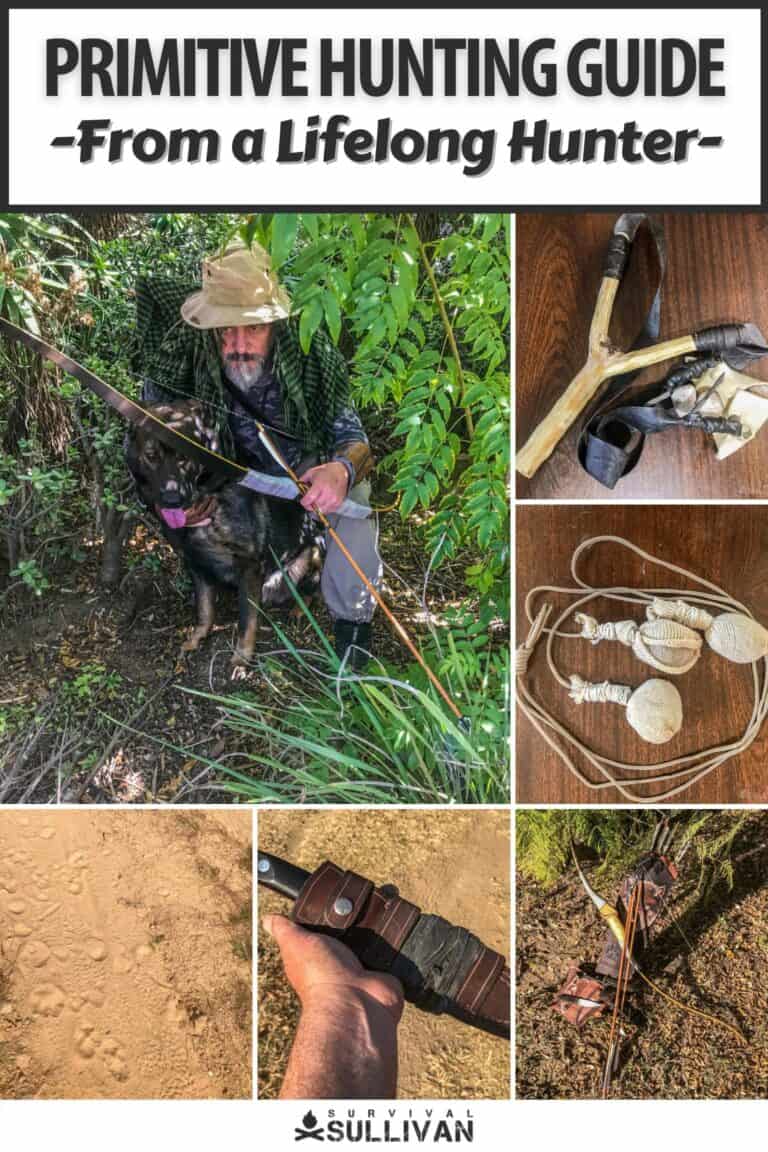

Harrison Caine is a soldier, a hunter, a trained expert in hand-to-hand combat, hunting. He’s trained soldiers, fought wars, and provided defense services to refugees and U.S. officials. His experience in tough wilderness scenarios is unmatched
